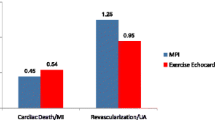Abstract
Peak-and post-exercise stress echocardiography were compared with respect to ability to detect coronary artery disease in 138 consecutive patients undergoing supine bicycle stress echocardiography. Sixty of these patients had single-vessel disease; 37, double-vessel disease; and 19, triple-vessel disease. Exercise was performed in the 20- to 30-degree left decubitus position on an echo-bed with an ergometer. Exercise started at 50 watts and was increased in 25-watt every 3 minutes and to a maximum of 150 watts. Two-dimensional echocardiographic images were digitized and assigned in a quad-screen format for nonbiased interpretation. Total wall motion score (TWMS) was the sum of the wall motion score, from normokinesis (0) to dyskinesis (4), of 16 segments. Image quality score index (IQSI) was the mean of the image quality scores in all views. All of the patients underwent coronary arteriography. Significant coronary stenosis was defined as≧75% stenosis of the large coronary arteries. Two-dimensional echocardiographic studies were adequate for analysis in 133 patients during the peak-exercise stage (peak-exercise) and in 137 patients 30 to 60 seconds after the end of exercise (post-exercise). TWMS at peak-exercise was higher than at post-exercise, while IQSI at peak-exercise was lower than at post-exercise. Sensitivity at peak-exercise versus that at post-exercise was 91% versus 79% (p<0.05); specificity, 76% versus 85%; and diagnostic accuracy, 88% versus 80% (p<0.05), respectively. We conclude that despite poor image quality on exercise echocardiography, better diagnostic accuracy was attained by assessing wall motion changes at peak-exercise than at post-exercise.
Similar content being viewed by others
References
Hecht HS, DeBord L, Sotomayor N, et al: Supine bicycle stress echocardiography: peak exercise imaging is superior to postexercise imaging. J Am Soc Echocardiogr 1993;6: 265–271.
Wann LS, Faris JV, Childress RH, et al: Exercise cross-sectional echocardiography in ischemic heart disease. Circulation 1979;60: 1300–1308.
Morganroth J, Chen CC, David D, et al: Exercise cross-sectional echocardiographic diagnosis of coronary artery disease. Am J Cardiol 1981;47: 20–26.
Hecht HS, DeBord L, Shaw R, et al: Digital supine bicycle stress echocardiography: a new technique for evaluating coronary artery disease. J Am Coll Cardiol 1993;21: 950–956.
Iliceto S, D'ambrosio G, Sorino M, et al: Comparison of postexercise and transesophageal atrial pacing two-dimensional echocardiography for detection of coronary artery disease. Am J Cardiol 1986;57: 547–553.
Ryan T, Segar DS, Sawada SG, et al: Detection of coronary artery disease with upright bicycle exercise echocardiography. J Am Soc Echocardiogr 1993;6: 186–197.
Presti CF, Armstrong WF, Feigenbaum H: Comparison of echocardiography at peak exercise and after bicycle exercise in evaluation of patients with known or suspected coronary artery disease. J Am Soc Echocardiogr 1988;1: 119–126.
Marwick TH, Nemec JJ, Pashkow FJ, et al: Accuracy and limitations of exercise echocardiography in a routine clinical setting. J Am Coll Cardiol 1992;19: 74–81.
Limacher MC, Quinones MA, Poliner LR, et al: Detection of coronary artery disease with exercise two-dimensional echocardiography: description of a clinically applicable method and comparison with radionuclide ventriculography. Circulation 1983;67: 1211–1218.
Armstrong WF, O'Donnell J, Dillon JC, et al: Complementary valve of two-dimensional exercise echocardiography to routine treadmill exercise testing. Ann Intern Med 1986;105: 829–835.
Ryan T, Vasey CG, Presti CF, et al: Exercise echocardiography: detection of coronary artery disease in patients with normal left ventricular wall motion at rest. J Am Coll Cardiol 1988;11: 993–999.
Armstrong WF, O'Donnell J, Ryan T, et al: Effect of prior myocardial infarction and extent and location of coronary disease on accuracy of exercise echocardiography. J Am Coll Cardiol 1987;10: 531–538.
Iliceto S, Rizzon P: Stress echocardiography: ready for routine clinical use? Eur Heart J 1991;12: 262–265.
Schiller NB, Shah PM, Crawford M, et al: Recommendations for quantitation of the left ventricle by two-dimensional echocardiography. J Am Soc Echocardiogr 1989;2: 358–367.
Austen WG, Edwards JE, Frye RL, et al: AHA committee report: a reporting system on patients evaluated for coronary artery disease. Circulation 1975;51: 7–40.
Bogaty P, Gavrielides S, Mure P, et al: Duration and magnitude of ST-segment depression during exercise and recovery: a symmetric relation. Am Heart J 1995;129: 666–671.
Currie PJ, Kelly MJ, Pitt A: Comparison of supine and erect bicycle exercise electrocardiography in coronary heart disease: accentuation of exercise-induced ischemic ST depression by supine posture. Am J Cardiol 1983;52: 1167–1173.
Thadani U, West RO, Mathew TW, et al: Hemodynamics at rest and during supine and sitting bicycle exercise in patients with coronary artery disease. Am J Cardiol 1977;39: 776–783.
Author information
Authors and Affiliations
About this article
Cite this article
Hirano, Y., Yamamoto, T., Uehara, H. et al. Diagnosis of ischemic heart disease with exercise echocardiography: Comparison of images obtained at peak- and post-exercise. J Med Ultrasonics 30, 241–246 (2003). https://doi.org/10.1007/BF02481287
Issue Date:
DOI: https://doi.org/10.1007/BF02481287




